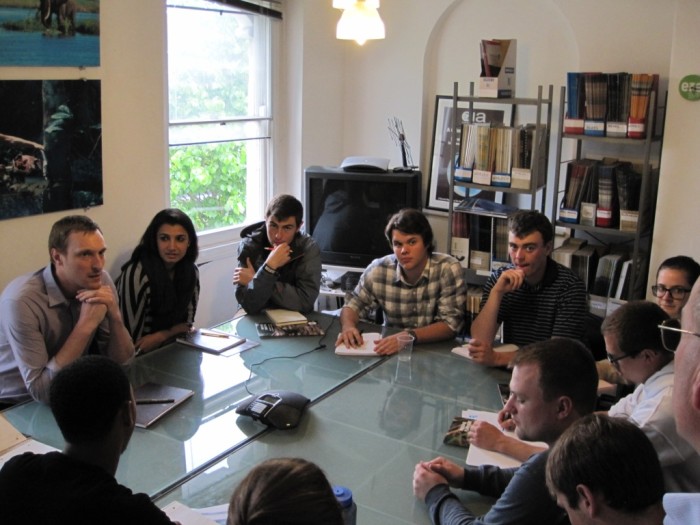A chance to share with future environmental champions
At EIA, we love to interact with future environmental champions as well as today’s environmental leaders. That’s why it’s always a great pleasure to host the students of Michigan State University’s course on Environmental Science, Policy and Criminology. What a great bunch of people, with diverse backgrounds and experience in researching and advocating better environmental practice, and what a privilege that such a prestigious body brings its students to hear from EIA’s investigators, analysts and campaigners firsthand. We were also delighted to host their meeting with Chris Smith of the UK’s Environment Agency, leading the fight against illegal e-waste shipments.
So, what did the students think of us, and what applications can they imagine for our techniques? Here, 12 of the Michigan State University students who recently visited EIA’s London offices as part of a study abroad program in the UK share what they took away with them …

Michigan State University students visit EIA
.Study Abroad: Environmental Science, Policy and Criminology
Our study abroad program is titled Environmental Science, Policy and Criminology in Scotland and England. We are from the Michigan State University in East Lansing, Michigan. This program entails a multidisciplinary approach to the complexities of maintaining a sustainable environment. As students, we are asked to compare US sustainable behavior with UK behavior. Students from our program come from a wide variety of backgrounds including, but not limited to, public affairs, environmental science and criminology. Our overall goal in this program is to use our existing knowledge of policy and criminology and compare it with the complexities of maintaining an environment. This comparison allows for the construction of an applicable solution on a worldwide scale. In order to achieve this goal, we must first go through set objectives we have compiled. Our first objective is to gather information of the environment and the issues at hand. Our second objective is to get a full understanding of current policy and enforcement issues dealing with environment crimes. Lastly, we are asked to come up with solutions to the problems in order to make sure we sustain our environment.
– Michael Allard & Xavier Burns
Links to EIA
As participants in Michigan State’s Environmental Science, Policy and Criminology in England and Scotland Study Abroad Program, our courses seek to provide students with an in-depth and multi-layered analysis to multiple aspects of fisheries and wildlife policy in the UK. Along with lectures on criminology, environmental science and the politics of protecting the environment, hands-on experiences with groups working to protect the environment in the UK give us a comprehensive view of the challenges and solutions of fisheries and wildlife. One of the most insightful experiences for this group was our meeting with the Environmental Investigation Agency (EIA). After talking with multiple members of their organisation, it was interesting to find how our coursework could intersect with their mission in so many ways. For example, the mission of EIA centres around unearthing facts about less publicised environmental crimes in order to bring awareness to the public and motivate policymakers to change environmentally harmful policies. A combination of our criminal justice studies and an explanation EIA’s work in undercover operations allowed us to fully grasp the important impact their work does to raise awareness of horrible crimes such as illegal logging or the killing of tigers.
– Aniela Butler & Brian Feeney
EIA methods
EIA is a very proactive organization. They take an aggressive and analytical approach to their work. They begin with extensive desk-based research, which includes suspect and/or company profiling, targeting criminal networks, sharing intelligence, risk assessment, etc. Comprehensive preliminary research reduces rates of failure, risk, and expenses. Before physically entering the field of investigation, the members of EIA must be familiar with the suspect and their methods of business, as well as their own undercover identity. Those undercover utilise various devices such as hidden cameras, voice recorders and binoculars, as well as other props that aid in furthering the investigation. Once out of the field, they must be prepared to interact with government and law enforcement in varying degrees. Overall, by implementing more intelligence-lead strategies, EIA has been able to more successfully raise awareness for the high prevalence of environmental crime in our world.
– Courtney Hammer & Chase Heise
EIA and tiger trade
Tigers are truly an iconic species. Over the past 100 years, however, their populations have decreased by 97 per cent. In response to this startling decline, China banned trade in wild tiger products in the 1990s, but did not ban the trade in captive tigers and their products. Today, there are 150 companies that legally obtain nationally protected animals, including tigers. EIA is working to promote awareness and prevent the extinction of the tiger through various events and investigations. The agency is actively working to document the illegal trade in tigers, while also monitoring the legal captive trade. This is especially important, as products from captive tigers are two to three times more expensive, giving an incentive to go after wild tigers. There is hope for the tiger, but EIA cannot save the species on its own. As consumers and stewards of wildlife and nature, we need to ensure that we support those companies that practice responsibly to protect our environment and wildlife instead of those actively promoting the destruction of species around the world.
– Dawn Lucas & Alex Martinez
EIA and illegal logging
During our visit to EIA, we were able to get an in-depth lecture about the illegal logging campaigns in Indonesia and Mozambique. Illegal logging causes immense deforestation in Indonesia and Mozambique. This deforestation not only causes huge damages to the surrounding wildlife but also the people residing in these areas. The illegal logging trade funds organised crime, which allows them to pay off border patrols and offer bribes to logging enforcement officials. Illegal loggers go to extreme lengths to protect their trade; one story told to us involved a standoff between an investigator and a contact and the owners of a logging company. The company tried to prevent him from escaping by turning off runway lights at an airport. Although it ended well, it showed the lengths to which people involved will go to protect their trade. To document the various crimes committed, the investigators used ruses and secret film (under the guise of bird-watching or as potential buyers) as a method to show how the trade network operated. This allowed them to expose the network to the greatest extent and show trends in how these resources were being trafficked the world over.
– Chelsea Punin & Blake Showers
Application of EIA methods beyond
EIA is a non-governmental organisation whose initiative is to expose potential environmental injustices such as illegal logging and tiger trade. While EIA is based in the UK, this type of NGO serves a global purpose, working incountries from Mozambique to China. As is typical of an undercover organisation, certain techniques must be employed to obtain evidence of illegal environmental crimes. These methods include the use of hidden cameras, creation of fake companies, phone numbers and names, and the use of crime analysis using intelligence webs; the intelligence webs are especially useful because these can present all the specific details of criminal networks that allow for missing information to be systematically filled in. These techniques are great for gaining incriminating evidence against illegal loggers in Mozambique, but they also have a great potential for applications in the United States, even in our home state of Michigan.
During the fall, Michigan has a hunting season for whitetail deer. In order to participate in hunting, you must purchase a permit from the DNR (Department of Natural Resources). This permit entails how many deer you can shoot and also the quantity of each gender. A new regulation was recently put into place, in which, if the buck does not have at least six points (on its antlers) you have to let them go. Sadly, many hunters illegally attain the deer without buying permits and respecting the newest regulation. If an NGO such as EIA were to exist in Michigan, they could apply their techniques in order to preserve the population of the whitetail in certain areas. For instance, undercover rangers could record the illegal activity on public land by using the camera method. Another method that could be used is if a DNR officer pretends to be a hunter on private land. He can talk to hunters that are partaking in the illegal hunting and follow them to their camp. Many hunters hunt in groups, therefore the probability of catching more illegal activity at a hunting camp is fairly high. Over time, these processes can reduce illegal hunting and increase overall environment law enforcement in the United States.
– Andrew Stables & Dilyn Zarb


